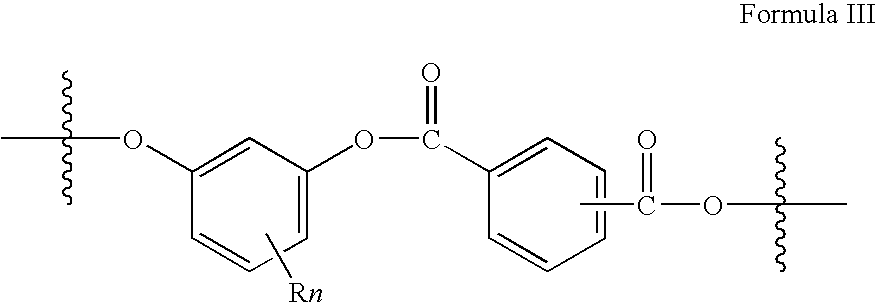Flame resistant polymer blends
a technology of flame retardant and polymer blend, which is applied in the direction of synthetic resin layered products, layered products, chemistry apparatus and processes, etc., can solve the problems of not having the flame retardant necessary to meet the far requirements, and achieve the effects of improving flame retardant performance, high tensile elongation at break, and improving heat releas
- Summary
- Abstract
- Description
- Claims
- Application Information
AI Technical Summary
Benefits of technology
Problems solved by technology
Method used
Image
Examples
examples
[0089] Blends were prepared by extrusion of mixtures of resorcinol-based polyester carbonate resin with a siloxane polyetherimide (siloxane PEI) or siloxane polycarbonate (siloxane PC) copolymer resin or other ingredients as mentioned in the tables 1 to 4, in a 2.5 inch single screw, vacuum vented extruder. Compositions are listed in wt % of the total composition except where noted otherwise. The extruder was set at about 250 to 310° C. The blends were run at about 90 rpm under vacuum. The extrudate was cooled, pelletized and dried at 120° C. Test samples were injection molded at a set temperature of 280-310° C. and mold temperature of 120° C. using a 30 second cycle time. Properties were measured using ASTM test methods. Melt flow index (MFI) was run on dried pellets as per ASTM D1238 at 295° C. using a 6.6 Kg weight, or at 300° C. using a 1.2 Kg weight, as noted. All molded samples were conditioned for at least 48 h at 50% relative humidity prior to testing. Notched Izod impact va...
examples a , 1-6
Examples A, 1-6
[0099] Table 1 shows blends of an ITR copolymer resin having about 90 mole % resorcinol ester containing linkages combined with a siloxane polyetherimide. As can be seen in examples 1 to 6 addition of the siloxane PEI, even at very low levels, gives a surprising reduction in two-minute and peak heat release compared to the control example A. With only 1.0 wt % siloxane PEI the peak heat release in example 5 is reduced by about 45% from 85 to 47 KW / m2. Note that the blends also retain modulus, strength and elongation. With low levels of siloxane PEI, the blends also are transparent (% T>50).
TABLE 1ExamplesA123456ITR901099.9499.8499.7499.5499.4598.9598.45PEI-Siloxane0.00.10.20.40.51.01.5aryl phosphite0.060.060.060.060.050.050.05Heat Release2 min (KW-min / m2)36343127202426Peak (KW / m2)85706058474734MFR@300° C.12.411.911.511.413.413.713.6Flex Mod Kpsi344340348360369372373Flex Str. Kpsi16.216.116.516.816.816.716.8T Str. (Y) Kpsi11.011.011.011.010.810.810.8% Elong (B)110951...
examples b-d , 7-9
Examples B-D, 7-9
[0100] Table 2 shows a series of ITR copolymers, where the resorcinol ester content (RMC) varies from about 60 to 20 mole %, blended with 2 wt % siloxane PEI. The copolymers with no siloxane PEI resin are shown as control examples (B, C, D). Note that the siloxane PEI is effective in reducing two minute and peak heat release values in all cases (examples 7, 8 and 9) compared to the ITR copolymers with no added siloxane copolymer. Also note the high notched Izod impact strength of the siloxane PEI blends. These examples also show that a higher resorcinol ester content (RMC) is more effective in reducing heat release values than a lower RMC. Blends with greater than about 40 mole % RMC have low two minute heat release (below 75 KW-min / m2) and low peak heat release values (below 80 KW / m2).
TABLE 2ExamplesB7C8D9ITR6040100980000ITR4060001009800ITR2080000010098PEI-Siloxane020202Heat Release2 min (KW-min / m2)75599370115105Peak (KW / m2)1017811777171122MFR@300° C.5.85.48.68.4...
PUM
| Property | Measurement | Unit |
|---|---|---|
| transmittance | aaaaa | aaaaa |
| haze | aaaaa | aaaaa |
| tensile elongation at break | aaaaa | aaaaa |
Abstract
Description
Claims
Application Information
 Login to View More
Login to View More - R&D
- Intellectual Property
- Life Sciences
- Materials
- Tech Scout
- Unparalleled Data Quality
- Higher Quality Content
- 60% Fewer Hallucinations
Browse by: Latest US Patents, China's latest patents, Technical Efficacy Thesaurus, Application Domain, Technology Topic, Popular Technical Reports.
© 2025 PatSnap. All rights reserved.Legal|Privacy policy|Modern Slavery Act Transparency Statement|Sitemap|About US| Contact US: help@patsnap.com



